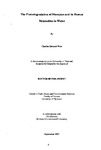The Photodegradation of Diazepam and its Human Metabolites in Water
| dc.contributor.author | West, Charles Edward | |
| dc.contributor.other | Faculty of Science and Engineering | en_US |
| dc.date.accessioned | 2013-10-21T11:32:14Z | |
| dc.date.available | 2013-10-21T11:32:14Z | |
| dc.date.issued | 2007 | |
| dc.identifier | NOT AVAILABLE | en_US |
| dc.identifier.uri | http://hdl.handle.net/10026.1/2254 | |
| dc.description | Merged with duplicate record 10026.1/687 on 27.03.2017 by CS (TIS) | |
| dc.description.abstract |
In recent years, the environmental occurrence, fate and effects of pharmaceuticals or pharmaceutically active compounds (PhACs) and their metabolites have received increased attention. PhACs have been detected in wastewater, river water, marine waters and even sewage sludge and soil. Since PhACs are developed with the intention of stimulating or inhibiting physiological responses, these findings have prompted concern over their environmental fate and potential adverse effects on nontarget ecological species. The major source of discharge of PhACs to the environment is through sewage treatment works (STWs) effluents and sludges. Although used in quantities similar to many agrochemicals and other organic micropollutants, PhACs are not required by legislation to undergo the same level of testing for possible environmental effects. Therefore, PhACs and their metabolites have been subject to many years of unrestricted emission to the environment. Typically, concentrations measured in municipal sewage treatment plant effluents are mg Lˉ¹, whilst those in the surface waters range from ng Lˉ¹ to µg Lˉ¹. The fate of PhACs in the aquatic environment is determined by both abiotic and biotic processes. Abiotic transformations in surface waters may occur via hydrolysis-and photolysis, with photolysis thought to be a significant factor in determining their environmental fate. In the present study, the anti-anxiety drug, diazepam (Valium®) along with its known human metabolites, nordiazepam, temazepam and oxazepam were selected for photodegradation studies. The photodegradability of each drug in distilled and natural waters was evaluated using a Suntest CPS Xenon arc lamp, selected to reproduce the spectral distribution of solar irradiation, with emphasis on the determination of degradation rate constants and half-lives under realistic environmental conditions. Solid phase extraction (SPE) methods were developed for extraction of these compounds from natural water samples and analysis was performed using high performance liquid chromatography (HPLC) separation with electrospray ionisation multistage mass spectrometry (ESI-MS") detection. Results demonstrated that whilst the compounds were hydrolytically stable in aqueous solutions, photolysis significantly reduced the concentration of diazepam and its metabolites in aqueous solutions. The measured half-lives (1 012) of diazepam, nordiazepam, temazepam and oxazepam in distilled water were 100, 193, 36 and 32 hours respectively. Novel photoproducts including 5-chloro-2-methylaminobenzophenone (m/z 246, [M+H]') and 2-amino-5-chlorobenzophenone (mlz 232, [M+H+] were detected and characterised by electrospray ionisation multistage mass spectrometry (ESI-MS") and comparison with reference compounds. The identities of a range of further photoproducts observed in aqueous solutions of photodegraded PhACs were proposed based on ESI-MS" data analysis. The presence of natural organic matter (NOM), specifically humic acids at environmental levels (1 mg Lˉ¹) were found to approximately double the rate of photodegradation for diazepam and nordiazepam (t½ 28 and 48 hours respectively). In contrast, results for the metabolites temazepam and oxazepam suggest that the presence of humic acids led to a reduction in the rate of photodegradation (t½ 72 and 66 hours respectively). The direct and indirect photodegradation kinetics determined in the present study for diazepam and its human metabolites were applied to UK river catchment models using a computer model, GREAT-ER. Maximum predicted environmental concentrations (PECs) were .determined for each compound and the impact of phototransformation on the removal of each compound was evaluated in two river catchments representing an urban/industrial catchment (river Aire) and a rural catchment (river Exe) respectively, under low now (summer) and mean now (winter) river conditions. The modelling predictions suggest that phototransformation may be an important process for removing diazepam and excreted human metabolites of diazepam from natural riverine and lacustrine environments. The overall results demonstrated that with photolysis half-lives ranging from 193-32 hours, diazepam and its human metabolites are unlikely to be persistent in natural waters. | en_US |
| dc.description.sponsorship | AstraZeneca, Brixham Environmental Laboratory | en_US |
| dc.language.iso | en | en_US |
| dc.publisher | University of Plymouth | en_US |
| dc.title | The Photodegradation of Diazepam and its Human Metabolites in Water | en_US |
| dc.type | Thesis | |
| dc.identifier.doi | http://dx.doi.org/10.24382/4684 |
Files in this item
This item appears in the following Collection(s)
-
01 Research Theses Main Collection
Research Theses Main


